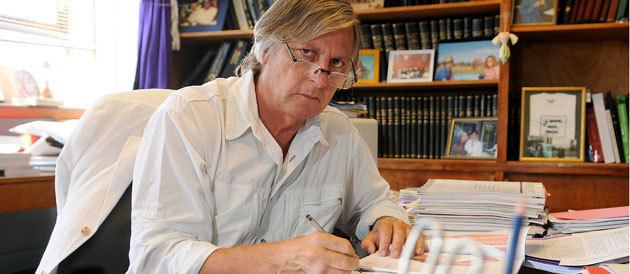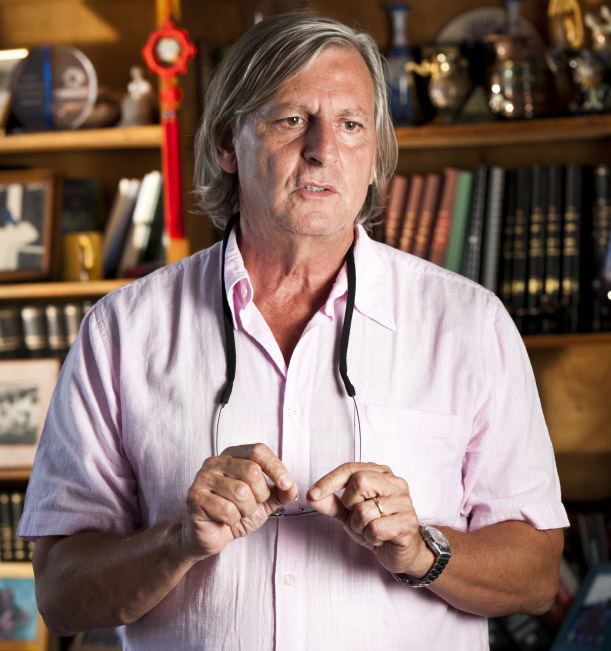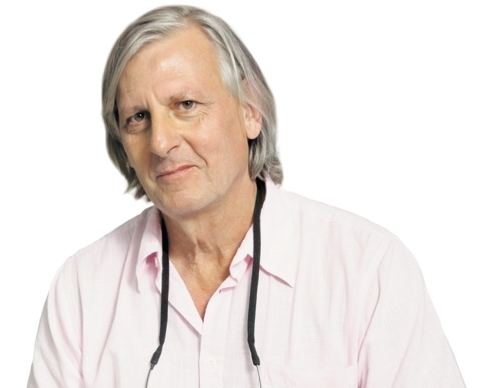Nationality French Name Didier Raoult | Fields Microbiology | |
 | ||
Institutions La Timone Hospital
Aix-Marseille University Books Rickettsiae and Rickettsial Diseases at the Turn of the Third Millenium | ||
Institution Aix-Marseille University | ||
Eccmid 2015 tv interview with prof didier raoult
Didier Raoult (born on March 13, 1952) is a French biologist. He holds MD and PhD degrees, and specializes in infectious diseases.
Contents
- Eccmid 2015 tv interview with prof didier raoult
- Didier raoult co laur at du prix scientifique 2015 de la fondation louis d
- Controversy
- Giant Viruses
- New bacteria
- Rickettsia Bartonella Q fever
- Clinical Microbiology
- Whipples disease
- Paleomicrobiology
- Microbiogenomic
- Microbial culturomics
- Probiotics
- HIV en route to endogenisation
- Didier Raoults book list
- References

In 1984, Didier Raoult created ex nihilo the Rickettsia Unit at Aix-Marseille University (AMU). He also teaches infectious diseases in the Faculty of Medicine of Aix-Marseille University, and since 1982 has supervised many M.D. and PhD degrees.

Since 2008, professor Raoult has been the director of "URMITE" i.e. the Research Unit in Infectious and Tropical Emergent Diseases, collaborating with CNRS (National Center for the Scientific Research), IRD (Research for the Development Institute), INSERM (National Institute of Health and Medical Research) and the Aix Marseille University, in Marseille. His laboratory employs more than 200 people, including 86 very active researchers who publish between 250 and 350 papers per year and have produced more than 50 patents. Didier Raoult is also involved in the creation of 8 startups to date.

Didier Raoult initiated the construction of a new building to host the Institut Hospitalo Universitaire (IHU) Méditerranée Infection, thanks to the highest grant available in France for medical research (73 million euros granted by the National Agency for Research). The IHU Mediterranée Infection, which opened in early 2017, is dedicated to the management and study of infectious diseases and combines diagnostic, care, research and teaching activities in one place.

On November 19, 2010, he was awarded the Inserm 2010 Grand Prix for his entire career.

He is "classified among the first ten French researchers by the journal Nature, for the number of his publications (a credit of more than two thousand) and for his citations number, as it was reported in 2008 by the daily economic newspaper resuming his work".
According to the Thomson Reuters source "Highly Cited Researchers List", Didier Raoult is among the most influential researchers in his field and his publications are among the 1% most consulted in academic journals. He is one of the 99 most cited microbiologists in the world and one of the 73 most highly cited French scientists. He is a world reference for Q fever and Whipple’s disease. In April 2017, on Google Scholar citations, he cumulated over 104,000 citations and an h index of 148. He is also on the list of the 400 most cited authors in the biomedical world.
According to the analysis of the publications from 2007 to 2013, by Kathleen Gransalke, for Labtimes (2017/02), Didier Raoult appears at the top of the European classification (including Israel) with 18,128 citations.
He totalises more than 2,300 indexed publications including 8 in Science, and 3 in Nature, the two most visible scientific journals according to the N&S index of the Shanghai's ranking.
Didier raoult co laur at du prix scientifique 2015 de la fondation louis d
Controversy
In July 2017, a police investigation was launched to enquire about allegations of harassment and sexual assault at the Institut Hospitalo Universitaire (IHU) Méditerranée Infection. A delegation comprising representatives (health, safety and working conditions committees (CHSCT)) of the CNRS, INSERM, IRD, and Aix-Marseille university has also conducted an investigatory visit related to working conditions within the new IHU.
Giant Viruses
Professor Raoult's team was the first to discover very large size viruses.
In 2003, Didier Raoult identified with Bernard La Scola a giant amoebic virus, mimivirus, and in 2004 established its genome.
In 2016, this team found in mimivirus a defense mechanism preventing the implantation of virophages in the virus plant (MIMIVIRE). Finally, it has been shown that this virophage could be integrated into the cells in the form of a pro-virophage and that it could be associated with transposon-like structures called transpovirons.
They also discovered Marseilleviruses and Faustoviruses.
The discovery of giant viruses seriously undermines the classification of viruses. Didier Raoult has several times reported that giant viruses are of a different nature than other viruses, and that they constitute a 4th branch of microbes known as TRUC for "Things Resisting Uncompleted Classifications".
New bacteria
Since the 1990s, Raoult and his team have identified and described approximately 96 new pathogenic bacteria and showed their implication in human pathologies. Two bacteria have been named for him: Raoultella planticola and Rickettsia raoultii.
Rickettsia, Bartonella, Q fever
Didier Raoult developed the field of culture of intracellular bacteria, then initiated the field of emerging rickettsioses and with his team identified 10 new species of human pathogenic Rickettsiae. The laboratory has rapidly become the National Reference Center (partnership with InVS France) and a WHO Collaborating Center. As a result, the samples for diagnosis are coming from many hospitals all around the world.
He has designed and co-authored two reviews used as references in the world, and has shown that Rickettsiae are transmitted by lice, fleas and ticks but also likely to be transmitted by mosquitoes, which is the case of Rickettsia felis, the most common species of Rikettsiae in the tropics.
Regarding Bartonella, the team was the first to identify their role in endocarditis.
For Q fever, a disease transmitted by the bacterial agent Coxiella burnetii, Didier Raoult found it necessary to redefine the criteria for diagnosis, to describe all aspects of the disease and to demonstrate the role of the bacterium in the genesis of Non-Hodgkin's lymphomas.
He highlighted, with his team, the role of anti-phospholipid antibodies in endocarditis and thromboses due to Coxiella burnetii. He recently described acute endocarditis and redefined persistent endocarditis. He has developed the therapeutic strategies currently used by the medical world (doxycycline and plaquenil), using for the first time plaquenil to alkalize the acidic vacuole in which the bacteria live, in order to allow the activity of the antibiotics inhibited by this acidity.
A book testifies to this whole work.
Clinical Microbiology
Didier Raoult has for long invested in various aspects of clinical microbiology.
His team was one of the first to use an automatic sequencer in a laboratory of clinical microbiology to obtain the sequences of 16S in order to identify the bacteria Then, his laboratory was the first to systematically use the MALDI-TOF for the identification of bacteria in routine analysis. Didier Raoult was also the first to set up a Point-of-Care laboratory in a hospital, his work has become an international reference.
Regarding endocarditis, Didier Raoult's team reported the highest number of cases of endocarditis with negative blood cultures and determined the etiologies of bacteria that were fastidious or destroyed by antibiotics. The team of Didier Raoult has proposed a specific treatment for blood cultures negative endocarditis and a new reference in the management of endocarditis which differs from the usual guidelines.
While studying pericarditis, Didier Raoult’s team reported the largest global series of pericarditis allowing, on the one hand, the etiological diagnosis of these infections and on the other hand, the discovery of viruses unknown in this situation.
This team has been working on tick-borne diseases since 1984 and has produced a large number of publications on rickettsial diseases, borreliosis and bartonellosis.
Whipple’s disease
Tropheryma whipplei, the causative agent of Whipple's disease, described in 1907 by Dr. Georges Hoyt Whipple, was isolated for the first time in the laboratory of Didier Raoult. His team is one of the two teams in the world who sequenced the genome of the bacteria. The discovery of Tropheryma whipplei has completely changed the profile of the disease and it is now accepted that the bacteria is relatively common in the environment or on the mucous membranes of the patients without necessarily being associated with the pathology.
He introduced a treatment for Whipple's disease that became the reference treatment by doxycycline and plaquenil, and describes the acute forms of the disease which include pneumopathies.
Paleomicrobiology
Mediterranea Harbour, Marseille was a city exposed to many epidemics. Thanks to a collaboration with anthropologists and odontologists teams, Didier Raoult, Michel Drancourt and Gérard Aboudharam inaugurated the field of paleomicrobiology. They developed an original technique for extracting DNA from the dental pulp and established the first retrospective diagnosis of the Black Death resurgence which took place in Marseille in the early 18th century then confirmed on plague samples from the 14th century that Yersinia pestis was the causal agent of the Black Death. This work was challenged by MT. Gilbert who for a long time maintained a polemic about the nature of the agent responsible for the Black Death.
Didier Raoult's team also showed that the Justinian plague was due to Yersinia pestis and postulated that the extremely rapid transmission of this bacterium was due to the infection of the louse which probably played the role of relay in this epidemic. These techniques also led to the discovery of the cause of the death of a part of the soldiers of Napoleon's army, during the retreat in Russia from a mass graves, discovered in Vilnius.
The possibilities for discoveries in this field are varied and promising.
Microbiogenomic
In 1999, Raoult decided to start a new program of genomics and to apply this to clinical microbiology. The team started with Rickettsia conorii and since then, 24 bacterial genomes have been sequenced, as well as those of 7 giant viruses (14 of these 31 sequenced genomes having been published).
Microbial culturomics
Microbial culturomics is a field that was created by Didier Raoult's team in 2008 to characterize the multiplication of culture techniques, identification by MALDI-TOF and confirmation by sequencing of the 16S RNA. This culture technique allowed to collect twice as many microbial species as the rest of the laboratories of the world together.
This new approach to biodiversity is applied to the human microbiota. Thus, in the study described in the journal Nature Microbiology in 2016, nearly 1,000 samples from the human digestive tract (stool, stomach, small intestine and colon) were analyzed, 1 170 different bacteria present in the digestive tract could be grown, including 247 completely new bacterial species. In addition, 269 bacteria that were known only in the environment were isolated for the first time in humans, and 250 bacteria that had already been isolated in humans but never in the digestive tract. All these new bacteria species are available in international collections of strains (Collection de Souches de l’Unité des Rickettsies, and Deutsche Sammlung von Mikroorganismen und Zellkulturen).
In a work carried out by the laboratory and published in Clinical Microbiology and Infection in September 2012, thhis technique allows to achieve five world records:
More than 30% of the cultured intestinal microorganisms have been identified by the team according to a recent review. In fact, this approach of the digestive microbiota has led to a rethinking of the role of the microbiota in malnutrition.
This high-throughput production of new species has made it compulsory to create a new approach to describing species called Taxonogenomics.
Probiotics
The last field of research developed by Raoult represents for him a major question of public health. It relates to the effects of probiotics and antibiotics on the gut flora of human beings and their possible effects on weight gain and weight loss. This is of particular relevance in terms of investigating possible causes of obesity.
In the journal Nature Reviews Microbiology of September 2009, Raoult indicated: "humans, particularly children, have been taking these same probiotics for many years, especially in fermented dairy products" and they would have their share of responsibility in the human obesity epidemic …"
In 2012, he and his co-workers reported on host-specific effects of Lactobacillus species on weight change. His view that lactobacillus may contribute to weight-gain in some humans is controversial. According to Raoult, recent research results "suggest that manipulating the composition of the gut microbiota may prevent weight gain or facilitate weight loss in humans".
HIV en route to endogenisation
A work led by Didier Raoult and published in 2014 made an analogy between the evolution of the koala retroviruses that currently experience on-going endogenization and apparent spontaneous cure of HIV infection in 2 patients never treated with antiretrovirals and with no HIV-related clinical symptoms and no HIV RNA or DNA detected in the blood by standard diagnosis tests. HIV sequences obtained from these two patients using modern sequencing technologies showed that HIV genes were inactivated by replacement of tryptophan codons by stop cdons, which is probably due to the action of a cellular enzyme, APOBEC. This work is a paradigm shift in HIV research that considered eradication of any HIV DNA from patients cells as a necessary step towards a possible cure. It provides opportunities for assessment of the chances for patients of a spontaneously favorable course of HIV infection, and for treatment through the use of APOBEC
Didier Raoult's book list
- Kazar J, Raoult D. Rickettsiae and Rickettsial diseases. Slovak Academy of Sciences ed. Publishing House of the Slovak Academy of Sciences, 1991.
- Argenson JN, Aubaniac JM, Curvale G, Groulier P, Drancourt M, Raoult D. L'infection ostéoarticulaire sur prothèse – Prévention, Diagnostic, Traitement. 1992.
- Raoult D. Antimicrobial Agents and Intracellular Parasites. Boca Raton: CRC Press Book, 1993
- Mege JL, Revillard JP, Raoult D. Immunité et Infection – Concepts immunologiques et perspectives thérapeutiques. Arnette, 1997.
- Raoult D. Maîtrise de la prescription des antibiotiques dans les hôpitaux. Elsevier ed. Paris: Elsevier, 1998.
- Raoult D. Dictionnaire de maladies infectieuses. Paris: Elsevier, 1998.
- Yu VL, Merigan TC, Barriere SL, et al. Antimicrobial Therapy and Vaccines. Williams & Wilkins, 1998.
- Raoult D, Nigoghossian JP, Cartapanis A. L'Université de la Méditerranée face aux défis du troisième millénaire. 1999.
- Raoult D, Tilton R. Dictionnary of Infectious Diseases. Elsevier ed. Paris: Elsevier, 1999.
- Raoult D. Les nouvelles maladies infectieuses. Que sais-je? ed. Paris: Presse Universitaires de France, 1999.
- Raoult D, Brouqui P. Rickettsiae and Rickettsial Diseases at the Turn of the Third Millenium. Paris: Elsevier, 1999.
- Yu VL, Weber R, Raoult D. Antimicrobial Therapy and Vaccine. 2d ed. New York: Apple Trees Production, LLC, 2002.
- Hechemy KE, Avsic-Zupanc T, Childs JE, Raoult DA. Rickettsiology – present and Future Directions. Annals of the New York Academy of Sciences ed. United States of America: K-M Research/PCP, 2003.
- Hechemy KE, Oteo JA, Raoult DA, Silverman DJ, Blanco JR. Rickettsioses – From Genome to proteome, Pathobiology, and Rickettsiae as an International Threat. Annals of the New York Academy of Sciences ed. New York: GYAT/PCP, 2005.
- Raoult D. Les nouveaux risques infectieux, grippe aviaire, SRAS et après ? Paris: Lignes de Repères, 2005.
- Hechemy KE, Oteo JA, Raoult DA, Silverman DJ, Blanco JR. Century of Rickettsiology – Emerging, reemerging Rickettsioses, Molecular Diagnostics, and Emerging Veterinary Rickettsioses. Annals of the New York Academy of Sciences ed. Boston,USA: Blackwell Publishing, 2006.
- Raoult D, Parola P. Rickettsial Diseases. New York: Informa Healthcare USA, Inc, 2007.
- Raoult D, Drancourt M. Paleomicrobiology – Past Human Infection, Springer, 2008.
- Raoult D. Dépasser Darwin, Plon, 2010.
- Didier Raoult, Eugene V Koonin, « Microbial genomics challenge Darwin », Frontiers in Cellular and Infection Microbiology, octobre 2012 (DOI 10.3389/fcimb.2012.00127)
- Raoult D. Grippe aviaire, SRAS : vivre avec les nouveaux risques infectieux, 2012
- Raoult D. De l'ignorance et de l'aveuglement : pour une science postmoderne. Ebook Kindle, Amazon, 2012.
- Raoult D. (en) Of Ignorance and Blindness, 2013, Ebook Kindle, Amazon.
- Raoult D. Votre santé : Tous les mensonges qu’on vous raconte et comment la science vous aide à y voir clair (en collaboration avec Sabine Casalonga), Michel Lafon, 2015.
- Raoult D. Arrêtons d'avoir peur !, Paris, Michel Lafon, 2016 (ISBN 9782749930039).
- Raoult D. Mieux vaut guérir que prédire, Paris, Michel Lafon, 2017 (ISBN 9782749932378).
